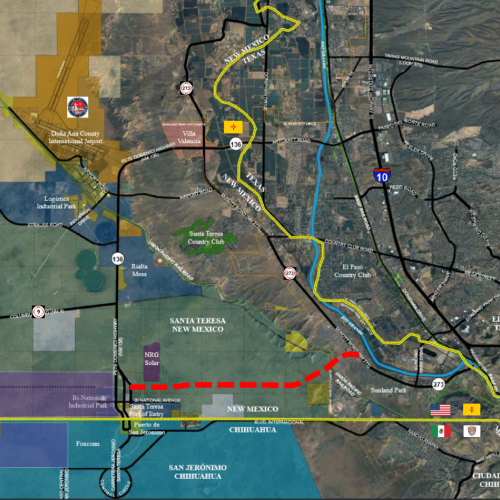Borderplex advantages:
- Located halfway between Long Beach CA and Houston TX.
- Connected to both east and west coasts via Interstate 10.
- Interstate 25 connects the region to the international border at Canada.
- International air and freight service at El Paso International Airport. The airfreight center at El Paso is the largest and most modern on the U.S./Mexico border.
- Two railroads serve the Borderplex, Burlington Northern Santa Fe, north connecting to the Transcon; and Union Pacific, east to Houston and west to Los Angeles/Long Beach.
- Union Pacific operates a $420 million intermodal facility in Santa Teresa.
- Businesses in the New Mexico Borderplex have access to state investment, workforce development programs, and a profitable tax climate.
- Doña Ana County is New Mexico’s only countywide Foreign Trade Zone (FTZ), #197.
- The Borderplex is less than two hours to Spaceport America or White Sands Missile Range.
- Companies enjoy the benefits of the USMCA.
- Served by the Santa Teresa Port of Entry, which provides fast access to the maquilas in Mexico.
Benefits of a Foreign Trade Zone (FTZ)
By reducing costs, FTZs level the playing field and improve U.S. competitiveness. FTZs can help businesses reduce production-, transaction-, and logistics-related costs by lowering effective duty rates, allowing special entry procedures, and encouraging production closer to market.
Specifically:
- No duties on imported goods that are later re-exported.
- Delayed payment of duties on goods that enter the U.S. market.
- Manufacturing-specific benefits, with case-by-case approval by the FTZ board, that can include reduction of duties if a lower tariff rate applies to the finished product leaving the zone that the tariff rates that would have applied on foreign components (“inverted tariff”).
- Elimination of duties on waste, scrap, and rejected or defective parts.
- Reductions in merchandise processing fees: zone users may be able to file a single customs “entry” (and pay a single fee) per week rather than making multiple entries during the course of a week.
United States-Mexico-Canada Agreement (USMCA)
The Commission on the Theft of American Intellectual Property (IP) estimates that China’s IP theft costs the United States between $225 billion and $600 billion annually. USMCA protects intellectual property rights with enforcement powers. The agreement also eases restraints on access to capital and minimizes the limits to where data can be stored and processed. This allows for faster and safe cross border transactions while protecting against cybersecurity threats.
USMCA addresses unfair currency practices with high standards to protect against competitive devaluations and increase transparency. It includes for the first time, articles to protect the environment – improve air quality, reduce and prevent marine litter, and support sustainable forest management.
One of America’s Fastest Growing Ports
The Santa Teresa Port of Entry (STPOE) is by far the fastest growing in New Mexico, and one of the fastest growing on the Mexican Border. STPOE is ranked 6th in total trade among the 167 land ports across the country. During the 15-year span between 2005 and 2020 commercial truck crossings quadrupled at STPOE. In fact, truck traffic continued to increase during the pandemic in large part due to freight delivery issues at other ports of entry.
- Despite the growth in commercial truck traffic, average wait times remain around 30 minutes.
View current STPOE wait times - The twelve-mile overweight cargo zone that surrounds both the Santa Teresa and Columbus Ports of Entry allows trucks entering New Mexico from Mexico to carry up to 96,000 lbs. of cargo even if they have a reducible load. The permit is $250 annually and is applied to a single truck, giving companies the flexibility to pay for only the trucks that will travel in the zone rather than an entire fleet.
- Only regional POE for hazardous materials such as gasoline.
- Best POE for oversized, overweight vehicles.
- Quick access to the more than 300 manufacturing companies in Ciudad Juarez, 63% of which are owned by U.S. companies.



